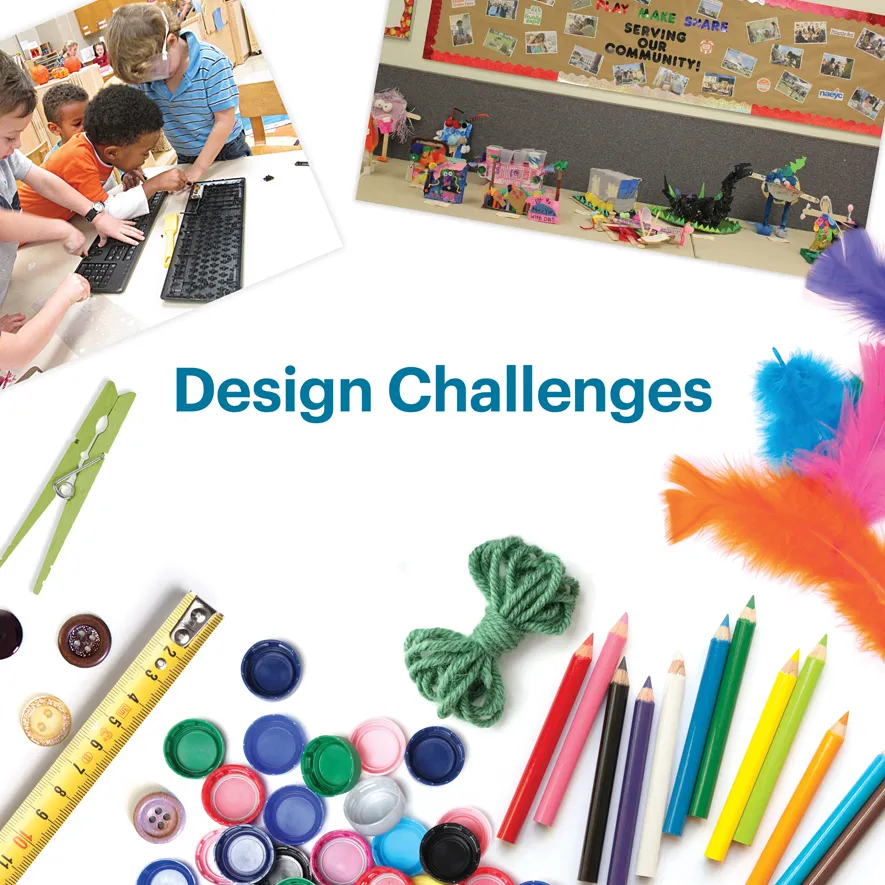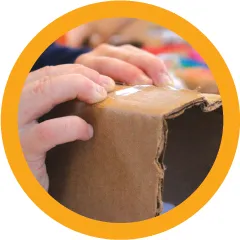
eBook - ePub
Making and Tinkering With STEM
Solving Design Challenges With Young Children
Cate Heroman
This is a test
Compartir libro
- English
- ePUB (apto para móviles)
- Disponible en iOS y Android
eBook - ePub
Making and Tinkering With STEM
Solving Design Challenges With Young Children
Cate Heroman
Detalles del libro
Vista previa del libro
Índice
Citas
Información del libro
Tinker, make, engineer—solving problems from picture books!
Can you build a sturdy house that is safe from the big, bad wolf?
Imagine your dream car. What special features does it have? What can you use to create it?
Teaching and learning STEM subjects (science, technology, engineering, and mathematics) is more accessible than ever before! Children will be inspired, delighted, and challenged as they use everyday materials and STEM concepts to design and build solutions to problems faced by characters in their favorite books. This practical, hands-on resource includes:
- 25 engineering design challenges appropriate for children ages 3–8
- Suggestions for creating a makerspace environment where children can tinker with materials, use tools to make creations, and improve on their ideas
- A list of 100 picture books that encourage STEM-rich exploration and learning
- Questions and ideas for expanding children's understanding of STEM concepts
- A planning template so you can create your own design challenges
Use engaging children's books together with the guidance and ideas in this book to extend children's problem-solving skills and creative thinking.
Preguntas frecuentes
¿Cómo cancelo mi suscripción?
¿Cómo descargo los libros?
Por el momento, todos nuestros libros ePub adaptables a dispositivos móviles se pueden descargar a través de la aplicación. La mayor parte de nuestros PDF también se puede descargar y ya estamos trabajando para que el resto también sea descargable. Obtén más información aquí.
¿En qué se diferencian los planes de precios?
Ambos planes te permiten acceder por completo a la biblioteca y a todas las funciones de Perlego. Las únicas diferencias son el precio y el período de suscripción: con el plan anual ahorrarás en torno a un 30 % en comparación con 12 meses de un plan mensual.
¿Qué es Perlego?
Somos un servicio de suscripción de libros de texto en línea que te permite acceder a toda una biblioteca en línea por menos de lo que cuesta un libro al mes. Con más de un millón de libros sobre más de 1000 categorías, ¡tenemos todo lo que necesitas! Obtén más información aquí.
¿Perlego ofrece la función de texto a voz?
Busca el símbolo de lectura en voz alta en tu próximo libro para ver si puedes escucharlo. La herramienta de lectura en voz alta lee el texto en voz alta por ti, resaltando el texto a medida que se lee. Puedes pausarla, acelerarla y ralentizarla. Obtén más información aquí.
¿Es Making and Tinkering With STEM un PDF/ePUB en línea?
Sí, puedes acceder a Making and Tinkering With STEM de Cate Heroman en formato PDF o ePUB, así como a otros libros populares de Education y Early Childhood Education. Tenemos más de un millón de libros disponibles en nuestro catálogo para que explores.
Información
Categoría
EducationCategoría
Early Childhood Education
Baby Bear’s Chair

LET’S LOOK AT THE PROBLEM
After a walk in the woods, the three bears return to their house to find Little Wee Bear’s chair broken, his porridge gone, and someone sleeping in his bed.
What do the three bears do about the broken chair? How do you think they could have fixed it? Have you ever fixed something that broke at home or at school? How did you do it?
MATERIALS
□ Reusable resources such as boxes, cardboard sheets and tubes, wood scraps, and craft sticks
□ Connectors such as tape, glue, a low-temperature glue gun, cardboard connectors, and brads
□ Tools such as scissors, child-safe cardboard cutters, and measuring tapes
□ Broken or nonworking items such as toys or small appliances
□ A balance scale and a 5 lb. weight
□ Paper and markers, crayons, or pencils
Safety note: Adult assistance needed in cutting cardboard
TINKER WITH THE MATERIALS
Pretend you work at a fix-it shop near the woods where Goldilocks might take Little Wee Bear’s chair to be repaired. Look at the broken things (toys and small appliances) and at the tools and materials you might use to fix them. What can you fix? Try some different connectors to hold things together. Which one seems to work best with the object you chose to fix?
STEM CONCEPTS
balance / design engineering / force / gravity / measurement / number concepts / patterning / scientific inquiry / stability

THE DESIGN CHALLENGE
Making Build a chair that stands on its own.
Engineering Build a stable chair that doesn’t wobble and can hold an object that weighs at least five pounds.
WORKING ON THE DESIGN CHALLENGE
• Think about it. How will you build the chair? What does your chair need to include? What will you do to make it stable? Draw or sketch your ideas.
Engineering. What part of Little Wee Bear’s chair do you think broke and why? What part of the chair does he sit on? What part keeps him off the floor? How can you use this information to design your chair? How will you make the chair strong so Goldilocks can’t break it?
• Build or create it. Gather your materials to build the chair. Make sure that it is strong and sturdy.
• Try it. Try to make the chair stand up on its own.
Engineering. What will you use for a five-pound weight? What is the most weight the chair will hold?
• Revise or make it better. Does it work? If it doesn’t, what can you change to make the chair better, stronger, or more stable?
Engineering. Is your chair stable (no wobbling)? Does it hold at least five pounds?
• Share. Tell someone about your chair and how you made it. Ask them if they have ideas about how to make it better.
Engineering. Test several chairs. Which one holds the most weight? Look closely at that chair and discuss with someone which features you think make it strong.
QUESTIONS AND COMMENTS
What do you think will happen if __________?
Tell me about your chair.
How much weight do you think your chair will hold?
What part do you think is the weakest? How could you strengthen that part?
BACK TO THE PROBLEM IN THE BOOK
Why do you think Little Wee Bear’s chair breaks but the other chairs do not?
How do you think your chair compares with Little Wee Bear’s chair?
GOING DEEPER
• Design a chair that reclines. What other tools and materials would you need? How would you make it?
• Use tools to take apart and/or fix a broken chair donated by a family, friend, school, or community member. What can you do to make it usable and look new again?
• What if animals could sit in chairs? How would you design and make a chair for a snake? a giraffe? a porcupine? an octopus? an ant?
• Examine different types of wheelchairs. How do they work? Interview someone who uses a wheelchair. What are their ideas for making it better? Design and make a prototype (model) of a wheelchair that helps a person do a special task or an activity.
OTHER BOOKS TO USE
A Chair for Baby Bear / Kaye Umansky, illustrated by Chris Fisher
A Chair for My Mother / Vera B. Williams
Peter’s Chair / Ezra Jack Keats
A Chair for My Mother / Vera B. Williams
Peter’s Chair / Ezra Jack Keats
Beautiful Buildings

LET’S LOOK AT THE PROBLEM
Iggy Peck began building at the early age of 2, when he built a tower from dirty diapers! As he grows, he continues to build things like a cathedral out of apples and a castle out of chalk. When he gets to second grade, his teacher forbids him to build anything more. But when the class goes on a field trip, it’s up to Iggy to rescue them all from trouble.
Why does Iggy’s teacher forbid him to build anything in class? What problem arises on the field trip? How does Iggy use his building skills to solve the problem?
MATERIALS
□ Reusable resources such as boxes, cartons, cardboard tubes, craft sticks, toothpicks, paper plates, plastic cups, pipe cleaners, wooden skewers, and drinking straws
□ Connectors such as tape, glue, brads, binder clips, rubber bands, playdough, clay, wire, and cardboard connectors
□ Tools such as scissors, measuring tapes, rolling pins, and pliers
□ Photos or magazine pictures of tall buildings in your community and other locations
□ 100 pennies
□ Paper and markers, crayo...